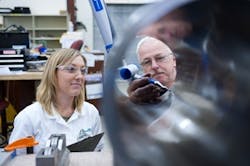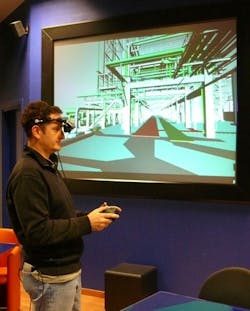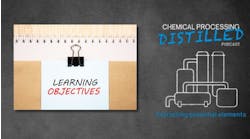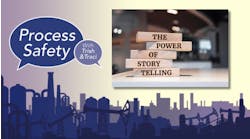Time and cost pressures are prompting a growing demand for shorter more-focused training sessions. For instance, a recent Chemical Processing survey found that more than 90% of respondents had either a high or moderate interest in "lunch and learn" presentations by vendors (www.ChemicalProcessing.com/articles/2009/001.html). However, both operating companies and suppliers still see a continuing need for longer more-traditional offerings. The challenge is how to most appropriately and effectively balance the two approaches.
"In order to be able to successfully meet international requirements in the future, we need employees who don't stop learning. That's why we still offer a high level of further training opportunities even despite the difficult economic times," says Michael Haubrich, who is responsible for qualification and training in operations for BASF, Ludwigshafen, Germany.
The company increasingly is relying on online methods. "This is not primarily for cost saving but rather for didactic reasons and because these tools help us to reach out to all our employees within a short period of time. Furthermore the young generation is more used to these kinds of methods," he adds.
BASF has extended its Education & Learning Portal globally; it currently has 30,000 registered users and features YouTube-like film sequences to explain certain contents in an easy-to-grasp and entertaining way.
The company also is expanding lunch-and-learn events at its learning center in Ludwigshafen. Here, two-to-three-hour sessions focus on practical work-related topics.
In addition, 2,000 employees who deal with technical tasks such as maintenance and planning at 100 sites worldwide can gain insights online via the company's virtual technical community (Figure 1). They can post questions, which generally are answered within a few hours.
[Related: Retirement Casts a Long Shadow]
BASF also has developed a program called Opal (for Optimization of Production in Antwerp and Ludwigshafen) to foster a consistent production system at its plants in the two locations. As part of the program, a dedicated training team spurs development of systematic and practical methods to support operating staff onsite — for example, via relevant lunch-and-learn sessions.
The firm's latest initiative is a pilot project to evaluate a computer-based training system for its Emergency Maintenance Service Centers. It will be implemented at four locations for 13 services — including fault clearance of control valves and measuring devices, programmable logic controllers (PLC) and distributed control systems (DCS).
"Knowledge is the prerequisite for an efficient fault clearance. The computer-based training system is a tool which should be used for job training, self-study and in practice on site. Furthermore, the retention of knowledge in the midst of demographic change is supported," explains Erhard Heusser, BASF vice president for maintenance.
Sharing Staff Knowledge
Air Products, Allentown, Pa., says e-learning is becoming a key tool in its training strategies. Use has climbed from 20% of all formal learning five years ago to about 66% today and continues to rise.
"We also know that a lot of learning comes via ways other than formal training. The question for us now is how to capture this knowledge and then formalize it to ensure the quality of the overall training — in other words, to formalize informal training," says John Zoeckler, global learning performance lead, Learning and Knowledge Management Center.
At the heart of this strategy are the company's Best Practice Communities. These hold monthly one-to-two-hour best-practice-sharing meetings to capture and disseminate knowledge among all the company's plants (Figure 2).
Better understanding of how to manage virtual communities and teams is another key issue. One recent project focused on worldwide interactions between operations staff — a small group received some coaching and then after four months exchanged lessons learned and experiences with each other. "These are now being recorded as a trilogy of webcasts which discuss the best practices developed. They will be made available via these webcasts to anyone, anywhere in the company," says Zoeckler.
Outside vendors also play an important role. For example, the company is partnering with Allen-Bradley on equipment-based training and with the online Accenture Supply Chain Academy for supply chain education and certification.
"The backside of this is our partnership with Knowledge Advisors in the use of 'Metrics That Matter.' This allows us to survey employees after training and allows them to rate the course, its instructor, etc. This gives us a good qualitative look at our course materials, how they are being delivered and whether they provide business value," says Jerry Lencoski, continuous improvement change manager and training specialist at Air Products.
And this activity links into SAP's Learning Solutions (LSO) module which Air Products has already rolled out around the world in 12 different languages to give 24/7 access to e-learning.
"Our LSO system also allows us to measure compliance. This is very powerful because it allows us to see the list of classes that are offered and whether they have been used sufficiently. How compliant are we? If it is a low score, this often means that we have a limited number of instructors or that they are not available locally. The question then is how to get them to where they are needed. When you bolt this together with 'Metrics That Matter' you can identify the classes that would best move from the classroom to the web-based approach," adds Lencoski.
As an example, he points to the "I's of Performance" course, where "I's" stands for ideas, involvement and interpersonal skills. The course is all about communication skills and is one that every member of Air Products' global operations must take.
"It's about a four-hour course and about 7,000 people need to take it. So this past year it went to a web-based approach which takes about 1–1.5 hours and is available to our employees 24/7," notes Lencoski.
For its part, DuPont Training Solutions, Virginia Beach, Va., part of DuPont Sustainable Solutions, also focuses on e-learning. It's released 16 online courses designed to help improve energy efficiency and profitability. Developed by DuPont's own energy engineers and consultants, the courses helped the company cut $47 million or 5% of its energy costs last year.
Topics include: energy management best practices, energy system instrumentation and controls, theory of steam generation, emission control and ash handling, pumping systems and steam distribution.
"Getting this material through instructor-led training — or anywhere else — would cost significantly more," contends Dan McGonegle, industrial skills manager, DuPont Training Solutions.
The Vendor View
"Our customers are looking for improved proficiency and productivity from their staff. For me the challenge is how to present the right curriculum — possibly in multiple languages and multiple locations — at the same time as delivering a consistent learning program," says Michele Triponey, senior vice president, global customer support and training, AspenTech, Burlington, Mass.
One of the newest demands she faces is for partnered, certified training programs. "We are working with five customers in different countries on such programs now. Two of these are major chemical operators, one in China and one in Venezuela. In effect, we are working together to create tests that can then be used by the companies' own trainers — i.e., we are customizing our own materials for their situations. Both of these companies are in emerging markets and they don't want to have to re-invent the wheel when it comes to training."
Since 2005 AspenTech has produced webinars on more than 60 topics. Recently it's been including more speakers from customers, who outline how and why they used a particular solution and the benefits realized. Each event is designed to last just an hour.
"The vast majority of companies can't send people on two-, three- or four-day courses in this economic climate and our feedback on webinars is very positive indeed. They are detailed enough to really give an insight into how to solve a particular problem using a particular tool," explains Sanjeev Mullick, director, product marketing.
All webinars are recorded and available on-demand, worldwide, 24/7.
In addition, AspenTech now offers five-minute-long online sessions that focus on how a certain feature of a product works. "We find that this is long enough to get across a core message, with links then on how to find out more information," says Mullick.
The company also is seeing a rise in demand for lunch-and-learn sessions. "More and more companies want just-in-time training, often in a specific aspect of a product. This is the new requirement that we are trying to cater for. There is a definite trend towards modularization. Gone are the days when staff could spend days and even weeks out of the office being trained," adds Vikas Dhole, vice president, engineering product management.
It's a similar story at Honeywell. "What's happening now is a shift towards web-based training, driven by economic realities. However, the bottom line is still that you will have a preferable experience if you come to a training center — you can get away and focus on learning. One of the issues that we have seen with web-based training is interruptions. Because you are at work, people assume that they can do this [interrupt]," says Tim Wyse, operations manager, Honeywell Automation College, Phoenix, Ariz.
Nevertheless, earlier this year the company rolled out the first of its new web-based training full-course packages (short modules have been available for some time). The training mainly focuses on the Experion process knowledge system. An instructor monitors each course, which all take a week. Virtual lab sessions can be accessed 24/7 via a remote server.
Honeywell has created a lunch-and-learn format for several live interactive webinars. "Additionally we are currently working on pre-recorded modules that cover important activities that are intended to provide refresher information and will last from 20 minutes to half an hour. We are still working on the logistics of the pre-recorded packages," notes Wyse.
This style of delivery also is being blended with more traditional training. For example, on some courses, users now are expected to have accessed eight hours' worth of material via webinars and podcasts before attending the actual course at a company training center.
In addition, the company has developed a mobile Experion system to deliver on-site training to groups of between six and 10.
An increasing push for staff certification in specific technologies will add to demand, Wyse believes. Users of its pulp-and-paper technology in Europe now must get certified, and this requirement likely will extend to other processes in the future, he says.
"The challenge is how to address the needs of different operators and different processes," says Dave Gillespie, leader, Honeywell Global Automation College, Ashland, Ky.
"I think in future there will be lots of e-training, possibly up to 50%. We have been working for about two years now trying to transfer our week-long courses into remote offerings. But, on the other hand, they are week-long courses for a good reason: we have a lot of information to get across. But there is a problem here because course content is always growing. We are at the point now where a week-long course (typically four-and-a-half days to allow traveling) cannot have any more information packed into it. They are at capacity. So this web access is a solution to that growing body of information," he explains.
Invensys also sees a shift. "We see a big change in the training market, especially for safety — also in the way that training is given. There is much more demand for compliance-based training now. It's also becoming more important to train people as a team now. So, we are looking more and more at reproducing a mirror of the plant, one that can be delivered in the field by virtual reality," says Maurizio Rovaglio, director of global consulting, Invensys Operations Management, Milan, Italy.
At the heart of this work is the company's new EYESim virtual reality immersive training solution (Figure 3). "We believe in the penetration of the message, in the way that the new generation of Playstations and Xboxes get their message across," he says.
With virtual reality EYEsim operators can learn a specific activity — for example, maintenance of a valve in a pressurized line — without leaving their work area. They give their onscreen avatar the necessary equipment and let their virtual representative do the task.
"Although EYEsim is very new, we are about to close a significant agreement to deliver it to a European petrochemical company. Management understand today that the new generation of operators need more appealing solutions and this gets the message across in a more penetrating way," he notes.
Seán Ottewell is Chemical Processing's Editor at Large. You can e-mail him at [email protected].





